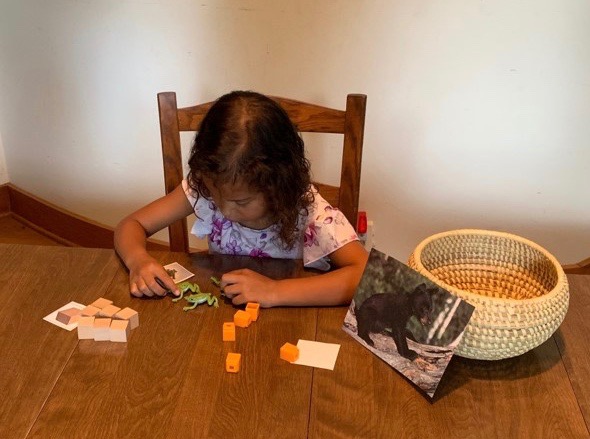1+ Players
Moderate teacher engagement
Materials
- Three “food” piles: One pile of 3 objects, one pile of 4 objects, and one pile of 5 objects. Each pile should use different objects and each of the small objects within one pile should be the same. For example, one pile of 3 counting cubes, one pile of 4 square blocks, and one pile of 5 triangle blocks.
- Three cards (one per “food” pile). Create your own cards or use these examples. Each card needs to match the “food” in that pile. For example, one card of counting cubes, one card of square blocks, and one card of triangle blocks.
- A dish or container to hold the “food.”
- A toy or picture to represent the hungry animal, such as this example.
Setup — Less than 5 minutes
- Children are the zookeepers and must feed the hungry animal! Gather the “food” piles.
- Create the cards or print the ones provided.
- Put the piles of “food,” cards, and a dish or container on a flat surface. Place the animal toy or picture by the dish.
Instructions
- Shuffle the cards and draw two (for example, the counting cubes card and the square blocks card). These are the two “food” piles that children will use to compare the quantities.
- Compare how many objects are in each of the two piles by counting or matching the objects one-by-one. Say: “The animal always wants to eat from the pile that has more. How many objects are in each pile?”
- If one pile has more, move one object from that pile into the dish.
- If the two piles have the same, put one object from either pile—not one from each pile—into the dish.
- Children take turns shuffling and drawing cards, comparing the piles, and moving “food” into the dish.
- The game ends when all the piles are empty or there is only one object left. The animal is full and happy. Good job, zookeeper!

Checks for Understanding
To deepen children’s learning about early math concepts, talk and ask questions while doing this activity together. Here are some examples to get you started:
- “How can you figure out how many blocks you have?”
- “How many frogs are there?”
- “How did you know to put in a frog toy and not a wooden block?”
- “You said you have three frog toys and seven blocks. Is three greater than seven or less than seven?”
- “Which food pile has more?”
- “How many more orange linking cubes do you have than frog toys?”
- “Since you started with five cubes, how many cubes will have left once you fed one to the bear?
Activity Modifications
Once you have tried the activity, here are some other things you can do. Try these modifications to keep the activity interesting and challenging for children all year.
- Use five frames or 10 frames to help children count objects side by side in order to compare.
- Create more than three piles of small objects.
- Use larger numbers of small objects, such as 15-18 objects per pile.
- Sets with similar quantities are more challenging to compare than sets containing very different numbers of objects. Have children use sets with a similar number of objects in each set (a set of 13, a set of 12, and a set of 14).
- To break a tie when two sets have the same number of objects, have children compare the number of each object already in the container and put in one of the least common types of objects. If the number of objects in the two sets is still equal, the child can choose which one to add.
- Play the game with a timer and have children try to fill their container before time runs out.
- During a tie, the child can choose one set and add the entire set to the container. That set is then eliminated from the game and that object type card is removed.
- Have children sort objects into their sets before beginning the activity as opposed to having all the objects together in the same container or the teacher being the one to sort the objects.
- Give roles to the participating children. Put one child in charge of a set of objects, and whenever that set of objects is drawn, that child is responsible for counting (for example, if frog toys are being used, the child always puts out the set of frog toys and counts it). Put one child in charge of the container and of counting how many of each object is in the container.